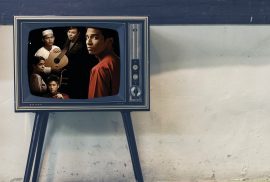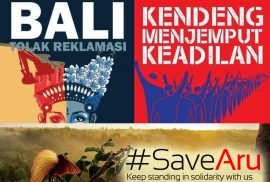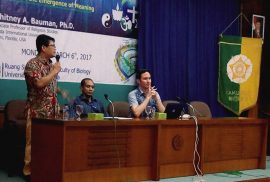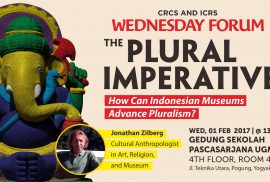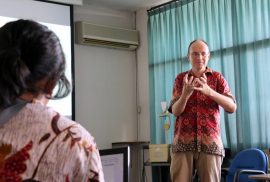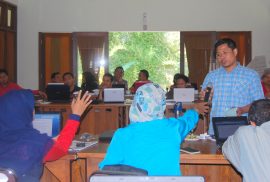A student's reflection on the Talentime movie watched in the CRCS's Religion and Film course.
religion
Jonathan D Smith | CRCS | Essay

Indonesia is home to many environmental movements, either led by established environmental activists or by groups of indigenous people. The reclamation project in Benoa Bay, cement mining in Kendeng area, Central Java, and the Save Aru movement are just a few recent examples. Does religion play a role in these movements? Are these local movements related to the growing global environmental movement?
The local and global is a crucial element of environmental movements, because environmental problems defy boundaries. Our rapidly-changing climate poses an urgent challenge that is both global and local. As national governments slowly acknowledge their role in reducing carbon emissions (with some exceptions), local communities in Indonesia are living with the problems of rising temperatures and sea levels, increases in natural disasters, and increasing pollution of our air and water.
Local-global connections in religious environmental movements
In 2016 at the climate summit in Morocco, governments met to affirm their adoption of the 2015 Paris Climate Agreement. Signed by 111 countries (as of November 2016), the agreement commits to reducing carbon emissions and recognizes the human impact on climate change. At the same climate summit in Marrakech, hundreds of religious leaders and environmental activists launched the Interfaith Climate Statement.
The Interfaith Climate Statement included these words:
Anang G Alfian | CRCS | News

Universitas Gadjah Mada’s Faculty of Biology invited Whitney Bauman to present his on-going project at the Biology Hall on Monday, March 6th, 2017. Students and lecturers from various faculties came to hear his lecture. His specialization on the discourse of religion, science, and nature reflects his capacity as an associate professor at the Department of Religious Studies, Florida International University, as well as author of works including Theology, Creation, and Environmental Ethics (Routledge 2009) and Religion and Ecology: Developing a Planetary Ethics (2014). A longtime friend of CRCS who has taught intersession courses more than once, he is currently working to finish his third, single-authored book with a tentative title Truth, Beauty and Goodness: Ernst Haeckel and Religious Naturalism.
In his lecture, introduced by paleontology lecturer Donan Satria Yudha as the moderator, Bauman engaged religion and science in a contemporary discussion to look for a new way of understanding each through an evolutionary perspective. This perspective of religion-science relationship was inspired by the contemporary phenomenon in which religion has gained more spaces within science.
The emphasis Bauman made in the beginning of the lecture pointed out the direction of his topic of presentation. He started how historically the notion of religion has been discussed by different perspectives from dualism and reductionism to emergence theory. Along with the continuum of religion-science relationship, he challenged to look at the relation in a new way by focusing on the German scientist Ernst Haeckel (1834-1919) who formulated a new way of making sense out of the world through his studies of ecology and evolution. Bauman clearly stated his stance: “to place Haeckel’s Monism in continuity with this tradition of meaning-making.” He also emphasized that everything has undergone changes and the way we understand the relation between religion and science has always been a “relationship in constant flux.” He challenged the assumption of the previous models on religion-science relationship that views Religion and Science as two different traditions. “I argue that Religion and Science are always together, influencing one another,” Bauman continued, “there is no clear separation.”
As Bauman prefers to define “religion” through its meaning-making function, he observed that the way religion attains knowledge is also inseparable from the natural evolution perspective. Further, he explained that the relation involves not only human and nature as a traditional dichotomy but more as an interconnectedness of everything. This view triggered questions from the audience.
One member of the audience asked a question on a human special status over the rest of nature which challenged the way certain traditions or religions view the status of humans in their scriptures. “I am not sure if humans have a special status in nature,” Bauman answered, “In fact, not only humans have culture and language; many other creatures might have them too.” Because knowledge is always in process and moves together with history and experiences, he argued that it is normal for many traditions to have different understandings of nature and the Truth.
Another question posed was about whether the first human walking on earth was the one as narrated in the scripture. Baumann referred to “Adam” as mentioned in the Genesis as its literal meaning, i.e. a creature on the earth which did not refer to any specific gender. In addition, Donan Satria Yudha said that some Muslim scientists say that Homo sapiens may constitute the first human as mentioned in the scripture and it refers to the quality of being human in the evolution, and not to a specific figure.
The writer, Anang G Alfian, is CRCS student of the 2016 batch

Abstract:
In this discussion, Jonathan Zilberg will discuss problems fracing Indonesian museum in terms of performance, accountability and transparency. He will discuss the Goverment of Indonesia’s 2010-2014 museum revitalization program, the transformations that have been taking place in Indonesia museum over the last decade and the challenges posed for the future. He will look at museums as democracy machines and as postcolonial centers for advacing the ideology of pluralism in civil society. In particular he will address the integrated importance of museums, adchives and libraris for advacing the state of education at all levels including for countinuing adult education.
Speaker:
Jonathan Zilberg is a cultural anthropologist specializing in art and religion and in museum ethnography. He has been studying Indonesian museums for a decade and is particularly interested in museums as democracy machines and as post-colonial centers for advancing the ideology of pluralism in civil society. His immediate interests focus on Hindu-Buddhist heritage including the function of archaeological sites as open air museums as well as of museum collections and government depositories in terms of being under-utilized academic resources. For comparative purposes, he has studied museums in Aceh, Jambi, Jakarta and to a lesser extent observed select museums elsewhere in Indonesia. Currently he is CRCS UGM Visiting Scholar.
Anang G. Alfian | CRCS | Class Journal
 One of the exciting courses at CRCS is “Religion and Globalization”. Dr. Gregory Vanderbilt, the lecturer, has approached the study in an active and critical manner involving all the students in class activities. According to him, throughout the class students are expected to increase their capability to raise questions concerning the relation between religion and globalization as he himself prefer framing the class in series of discussions with world-wide ranges of topic.
One of the exciting courses at CRCS is “Religion and Globalization”. Dr. Gregory Vanderbilt, the lecturer, has approached the study in an active and critical manner involving all the students in class activities. According to him, throughout the class students are expected to increase their capability to raise questions concerning the relation between religion and globalization as he himself prefer framing the class in series of discussions with world-wide ranges of topic.
As an American lecturer who has been working with CRCS since 2014 through Eastern Mennonite University, Virginia, he is a very well-experienced educator as he previously spent some years teaching in Japan. Moreover, his interest in following up the up-dated global issues including religious nuances, made him familiar with framing the methods of studying religion and globalization.
Global ethics is one of the topics we discussed in the class, the last material before the end of the class. Previously, we talked a lot about globalization as a phenomenon affecting religions as well as several religious responses toward globalization. Despite the supporters of globalization, many religions seem to fearfully reject it, some even proclaiming their resistance and becoming more radical.
 Given the case of the famous forgery the Protocols of the Elders of Zion, an issue which is widely spread even in Japan (as well as Indonesia) is that Jews are the scary ghost behind a world conspiracy that can eventually make Japan as its next target. At least, this is what had affected Aum Shinrikyo, a radical religious sect, to declare war on Jews conspiracy and blaming them for brain-washing Japanese people. In 1995, this sect even became more radical and went wild killing tens of people in the Tokyo subway by poisoning them with deadly gas and injuring thousands of victims. Their resistance is, in fact, affected by global issues brought by high velocity of information through media and technology which successfully landed in the minds of traditional society. In this case, Aum Shinrikyo shows the same fundamentality as that of the terrible bombing of 9/11 in New York City by international terrorist network, Osama Bin Laden. In Rethinking Fundamentalism, a book we discussed in the class, we could see the influences of globalization toward religious community attitudes caused apparently by their fear, and their will for religious purification from distortion they see as brought by globalization.
Given the case of the famous forgery the Protocols of the Elders of Zion, an issue which is widely spread even in Japan (as well as Indonesia) is that Jews are the scary ghost behind a world conspiracy that can eventually make Japan as its next target. At least, this is what had affected Aum Shinrikyo, a radical religious sect, to declare war on Jews conspiracy and blaming them for brain-washing Japanese people. In 1995, this sect even became more radical and went wild killing tens of people in the Tokyo subway by poisoning them with deadly gas and injuring thousands of victims. Their resistance is, in fact, affected by global issues brought by high velocity of information through media and technology which successfully landed in the minds of traditional society. In this case, Aum Shinrikyo shows the same fundamentality as that of the terrible bombing of 9/11 in New York City by international terrorist network, Osama Bin Laden. In Rethinking Fundamentalism, a book we discussed in the class, we could see the influences of globalization toward religious community attitudes caused apparently by their fear, and their will for religious purification from distortion they see as brought by globalization.
Therefore, to foster the stabilization of the world order from war and disputes, it is necessary to rethink globalization in ways that are more ethical and friendly to the world. On the topic discussion of global ethics, we learned about attempts by world organizations like the United Nations in generating international agreements including the UN Declaration on Human Rights. Besides, other agreements such as the Cairo and Bangkok Declarations represent local voices which to some points define human rights differently.
The difference in worldviews among international actors is interesting because each organization tries to define a global value within their own relativities. Moreover, some theories think that UN Declaration on Human Right is a Western domination over other cultures without considering cultural relativities, including religions, each of which inherits different theological and structures while at the same time sharing common values like peace, humanity, equality, and justice.
World issues indeed became valuable perspective in this class. Students are meant to not only understand theories but also keep updating their knowledge on what is happening in the recent international world. While negative influences of globalization such as war, religious radicalization, and other world disputes were discussed in the class, there is also a hope for a global agreement and bright future by sharing noble values like cooperation, justice, human dignity, and peace on global scale. The existence of world organizations and religious representatives in fostering global ethics proves the progress made towards creating world peace. The duty of students, in this case, is to contribute academically to spreading such values without neglecting the variety of cultural and religious perspectives.
*The writer is CRCS’s student of the 2016 batch.
Anang G. Alfian* | CRCS | Class Journal

Salah satu mata kuliah yang diajarkan di CRCS adalah Religion, Violence, and Peace Building (Agama, Kekerasan, dan Perdamaian). Tiga kata kunci ini menjadi variabel dan titik tolak diskusi tentang hubungan agama dan konflik sosial dan bagaimana upaya untuk membangun perdamaian.
Diampu oleh Dr. Iqbal Ahnaf, mata kuliah ini membahas, antara lain, persoalan relasi antara agama dan konflik. Ini dibahas di pertemuan pertama untuk membuka wawasan tentang perdebatan yang terjadi mengenai hubungan kausalitas antara agama dan kekerasan.
Pada pertemuan ini, satu dari dua bacaan yang dipakai sebagai bahan readings adalah artikel dari Andreas Hasenclever dan Volker Rittberger, Does Religion Make a Difference?: Theoretical Approaches to the Impact of Faith on Political Conflict (Journal of International Studies, 2000).
Dalam artikel itu, Hasenclever dan Rittberger memaparkan tiga mazhab dalam dunia akademik dalam membaca hubungan agama dan konflik, yaitu (1) primordialis, (2) instrumentalis, dan (3) konstruktivis.
Kaum primordialis berpandangan bahwa agama dalam dirinya sendiri memiliki unsur inheren yang dapat menyebabkan konflik. Ketika terjadi “konflik agama”, agama dibaca oleh kaum primordialis sebagai variabel yang independen, unsur yang tidak bergantung pada aspek-aspek lain, dan perbedaan identitas keagamaan itu sendiri bisa cukup sebagai penyebab konflik.

Kaum instrumentalis melihat peran agama dalam “konflik agama” sebagai instrumen saja, dan tidak memiliki peran objektif dalam dirinya sendiri. Menurut kaum instrumentalis, penyebab utama konflik adalah kepentingan politik dan ekonomi. Bagi kaum instrumentalis, agama hanya berperan dalam retorika saja, dan relasinya dengan konflik bersifat semu belaka.
Kaum konstruktivis tampak berada di tengah-tengah antara kedua kelompok di atas. Konstruktivis bersetuju dengan instrumentalis dalam hal bahwa penyebab fundamental konflik bukanlah agama, melainkan kepentingan politik dan ekonomi. Namun konstruktivis juga bersepakat dengan primordialis dalam hal bahwa agama memiliki peran nyata objektif, namun bukan sebagai penyebab utama, melainkan eskalator konflik. Agama, ketika terlibat dalam konflik, dapat membuat konflik semakin mematikan, deadly. Juga, berbeda dari primordialis yang berpandangan bahwa agama menjadi variabel independen dalam konflik, bagi kaum konstruktivis agama berperan secara dependen, tergantung pada faktor-faktor ekonomi dan politik lain yang melingkupi konflik tersebut; seberapa besar peran agama mengeskalasi konflik tergantung pada seberapa akut benturan antar kepentingan politik dan ekonomi dalam konflik itu.
Ketiga cara pandang di atas tidak bisa diperlakukan secara universal. Tapi ketiganya bisa dijadikan lensa analitis dan ditempatkan dalam suatu spektrum. Bagaimana menentukan peran agama dalam suatu konflik mestilah dimulai dari detil kasus konfliknya, lalu naik melihat lensa-lensa analitis yang ada, kemudian menentukan di antara yang tersedia manakah penjelasan yang lebih tepat.
Dalam “kasus Sunni-Syiah” Sampang, misalnya, dimensi konflik yang terjadi bukan hanya karena faktor perbedaan ideologis semata, namun juga karena adanya instrumentalisasi agama oleh elite politik, karena konflik ternyata bereskalasi pada masa perebutan kekuasaan menjelang pemilu daerah, sehingga narasi-narasi agama di legitimasi sedemikian rupa untuk suatu tujuan politik. Dalam melihat hal ini, kita tak bisa berhenti pada pandangan kaum primordialis—inilah pandangan yang diadopsi oleh mereka yang memercayai bahwa konflik Sampang itu adalah konflik Sunni-Syiah. Dimensi sosial politik dalam konflik itu wajib dihitung, mulai dari yang kecil seperti persengkataan internal keluarga, perebutan umat, hingga yang lebih makro seperti instrumentalisasi konflik untuk mendulang dukungan dalam pemilu.
Dalam perspektif konstruktivis, intervensi terhadap konflik dengan menyuarakan nilai-nilai kebajikan agama, kearifan lokal, dan slogan-slogan orang Madura Sampang sangat membantu upaya rekonsiliasi konflik, yakni untuk melakukan deskalasi terhadap konflik itu dengan mengajukan narasi tandingan primordialis. Penelitian Dr. Iqbal Ahnaf beserta peneliti yang lain dalam serial laporan CRCS tentang kehidupan beragama di Indonesia yang bertajuk Politik Lokal dan Konflik Keagamaan menunjukkan instrumentalisasi agama oleh elit politik di Sampang menjelang pilkada. Tesis S2 terkait kasus Sampang ini juga ditulis oleh mahasiswa CRCS angkatan 2010 Muhammad Afdillah yang kini telah dijadikan buku dengan judul Dari Masjid ke Panggung Politik.
Kasus Sampang merupakan contoh yang bagus untuk membaca seberapa besar peran agama dalam konflik, dan ini membutuhkan data dan analisis yang cermat. Contoh-contoh lain dari yang terjadi di Indonesia yang bisa diambil ialah kasus Ambon dan Poso, atau yang belum lama ini terjadi seperti di Tolikara, Tanjungbalai, atau bahkan kasus dugaan “penodaan agama” dalam pilkada Jakarta.
*Penulis adalah mahasiswa CRCS angkatan 2016

